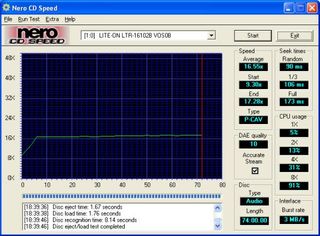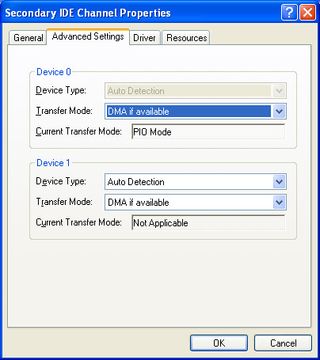The Next Step, Hi-Speed USB 2.0
Results - Test 1, Stage 3
To really see if USB 2.0 is all it is cracked up to be, and because the Impulse uses a standard IDE drive, we decided to remove the LITE-ON drive from the Impulse cage so we could see how USB 2.0 compares to an IDE device.

Test 1, Stage 2 - Results of the Digital Audio Extraction test with the LITE-ON drive removed from the Impulse and attached to an IDE channel.
As you can tell, we didn't get the results that one would expect from a 40x IDE drive. The problem appears to lie in the firmware of the drive. According to the LITE-ON web site, the 16102B is full DMA capable, but when we looked at the Secondary IDE Channel properties, we saw that the drive was running in PIO mode. We believe that IOGear made this firmware change to help improve the performance of the drive in a USB enviorment.

With the LITE-ON drive attached to the secondary IDE channel, we see that the drive doesn't support DMA mode.
Also, the drive isn't running a standard firmware that is listed on LITE-ON's website. The other thing is that it is running in P-CAV mode, or Partial Constant Angular Velocity. Partial Constant Angular Velocity is when the drive's transfer rate increases until it reaches its maximum speed. After maximum speed is obtained, it will slow down to maintain a constant transfer rate.
The drive should have been in CAV mode and the graph should have looked more like the Stage 2 graph.
This isn't a downfall of the drive; the drive does exactly what IOGear says it will do. It functions perfectly as a USB 2.0 device. Its Digital Audio Extraction scores are very good, and they are comparable to most IDE drives.
Stay on the Cutting Edge
Join the experts who read Tom's Hardware for the inside track on enthusiast PC tech news — and have for over 25 years. We'll send breaking news and in-depth reviews of CPUs, GPUs, AI, maker hardware and more straight to your inbox.
Most Popular

